
Probainognathus meaning “progressive jaw” is an extinct genus of cynodonts that lived around 235 to 221.5 million years ago, during the Late Triassic in what is now Argentina. Together with the genus Bonacynodon from Brazil, Probainognathus forms the family Probainognathidae. Probainognathus was a relatively small, carnivorous or insectivorous cynodont. Like all cynodonts, it was a relative of mammals, and it possessed several mammal-like features. Like some other cynodonts, Probainognathus had a double jaw joint, which not only included the quadrate and articular bones like in more basal synapsids, but also the squamosal and surangular bones. A joint between the dentary and squamosal bones, as seen in modern mammals, was however absent in Probainognathus.
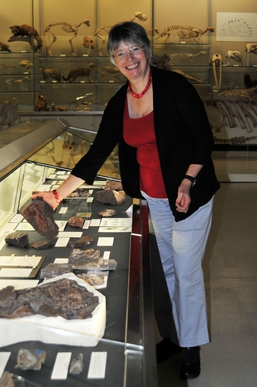
Jennifer Alice Clack, was an English palaeontologist and evolutionary biologist. She specialised in the early evolution of tetrapods, specifically studying the "fish to tetrapod" transition: the origin, evolutionary development and radiation of early tetrapods and their relatives among the lobe-finned fishes. She is best known for her book Gaining Ground: the Origin and Early Evolution of Tetrapods, published in 2002 and written with the layperson in mind.
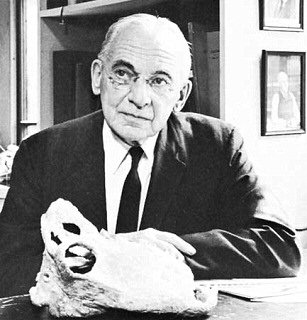
Alfred Sherwood Romer was an American paleontologist and biologist and a specialist in vertebrate evolution.
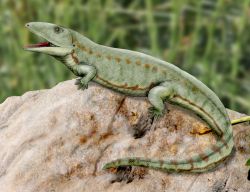
"Labyrinthodontia" is an informal grouping of extinct predatory amphibians which were major components of ecosystems in the late Paleozoic and early Mesozoic eras. Traditionally considered a subclass of the class Amphibia, modern classification systems recognize that labyrinthodonts are not a formal natural group (clade) exclusive of other tetrapods. Instead, they consistute an evolutionary grade, ancestral to living tetrapods such as lissamphibians and amniotes. "Labyrinthodont"-grade vertebrates evolved from lobe-finned fishes in the Devonian, though a formal boundary between fish and amphibian is difficult to define at this point in time.
Romer's gap is an example of an apparent gap in the tetrapod fossil record used in the study of evolutionary biology. Such gaps represent periods from which excavators have not yet found relevant fossils. Romer's gap is named after paleontologist Alfred Romer, who first recognised it in 1956. Recent discoveries in Scotland are beginning to close this gap in palaeontological knowledge.

Pederpes is an extinct genus of early Carboniferous tetrapod, dating from 348 to 347.6 Ma in the Tournaisian age. Pederpes contains one species, P. finneyae, 1 m long.
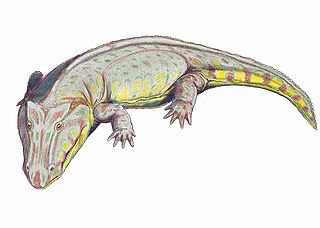
Edops is an extinct genus of temnospondyl amphibian from the Late Carboniferous - Early Permian periods. Unlike more advanced temnospondyls of the time, such as Eryops, Edops exhibited an archaic pattern of palatal bones, and still possessed various additional bones at the back of the skull. Edopoids also had particularly big premaxillae and proportionally small external nostrils. Within the clade, the most basal member seems to be Edops from the Early Permian Archer City Formation of the US, a broad-skulled animal with large palatal teeth.
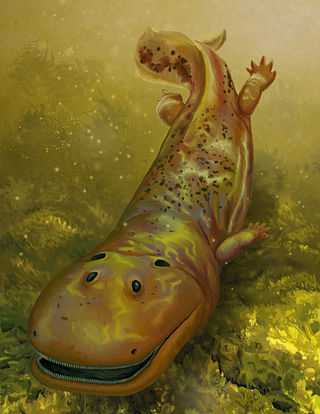
Spathicephalus is an extinct genus of stem tetrapods that lived during the middle of the Carboniferous Period. The genus includes two species: the type species S. mirus from Scotland, which is known from two mostly complete skulls and other cranial material, and the species S. pereger from Nova Scotia, which is known from a single fragment of the skull table. Based on the S. mirus material, the appearance of Spathicephalus is unlike that of any other early tetrapod, with a flattened, square-shaped skull and jaws lined with hundreds of very small chisel-like teeth. However, Spathicephalus shares several anatomical features with a family of stem tetrapods called Baphetidae, leading most paleontologists who have studied the genus to place it within a larger group called Baphetoidea, often as part of its own monotypic family Spathicephalidae. Spathicephalus is thought to have fed on aquatic invertebrates through a combination of suction feeding and filter feeding.

Megalocephalus is an extinct genus of baphetid amphibian from the late Carboniferous of the British Isles and the United States (Ohio). It contains two species, M. pachycephalus and M. lineolatus.

Ossinodus is an extinct genus of stem tetrapod. Fossils have been found from the Ducabrook Formation in Queensland, Australia dating back to the middle Visean stage of the Early Carboniferous (Mississippian). It was originally placed within the family Whatcheeriidae, but the absence of an intertemporal bone as suggested by a recent reconstruction of the skull based on fragmentary material may prove it to be stemward of all whatcheeriids.

Ichthyostegalia is an order of extinct amphibians, representing the earliest landliving vertebrates. The group is thus an evolutionary grade rather than a clade. While the group are recognized as having feet rather than fins, most, if not all, had internal gills in adulthood and lived primarily as shallow water fish and spent minimal time on land.
Blue Beach is a 2 kilometres (1.2 mi) stretch of cliff-bordered coastline at Avonport, Nova Scotia near the mouth of the along the Avon River in the southern bight of Minas Basin, Kings County, Nova Scotia, Canada. It is best known as a globally significant fossil location for Lagerstätte of the Tournaisian Stage period.

Occidens is an extinct genus of stem tetrapod from the Early Carboniferous (Tournaisian) Altagoan Formation of Northern Ireland. It is known from a single type species, Occidens portlocki, named in 2004 on the basis of a left lower jaw described by British geologist Joseph Ellison Portlock in 1843.

The Ballagan Formation is a geologic formation in Scotland and England. It preserves fossils dating back to the early part of the Carboniferous period. Its name comes from the "Ballagan Beds" of Ballagan Glen, near Strathblane, which has a good example of this geological formation.
Aytonerpeton is an extinct genus of stem-tetrapod from the Ballagan Formation of Scotland. It was one of five new genera of early limbed vertebrates from the Ballagan Formation described by Clack et al. in 2016. These vertebrates were among the only known in the world from a period of time known as Romer's gap. Romer's gap, which spans most of the Mississippian age of the Carboniferous, is characterized by a comparative rarity of tetrapod and stem-tetrapod fossils compared to the periods of time directly older and younger than it. However, Aytonerpeton and other Ballagan stem-tetrapods help to close in this gap in the vertebrate fossil record.
Diploradus is an extinct genus of four-limbed stem-tetrapod from the Mississippian (mid-Tournaisian) of Scotland. It contains a single species, Diploradus austiumensis, based on an incomplete skull and jaw fragments from the Ballagan Formation at Burnmouth. The most complete part of the specimen, the lower jaw, was about 3.0 cm in length and possessed several rows of small, numerous teeth. It likely represents a juvenile animal. Diploradus was described in a 2016 study which was devised to fill in the tetrapod and stem-tetrapod faunas of Romer's gap, an interval of the early Carboniferous with few vertebrate fossils. It was one of five new genera named in this study, along with Aytonerpeton, Koilops, Ossirarus, and Perittodus.
Koilops is an extinct genus of four-limbed stem-tetrapod from the Mississippian (mid-Tournaisian) of Scotland. It contains a single species, Koilops herma, based on a mold of an 8.0 cm -long skull from the Ballagan Formation. A phylogenetic analysis in its original description places Koilops as a close relative of Tulerpeton and colosteids. Koilops was described in a 2016 study which was devised to fill in the tetrapod and stem-tetrapod faunas of Romer's gap, an interval of the early Carboniferous with few vertebrate fossils. It was one of five new genera named in this study, along with Aytonerpeton, Diploradus, Ossirarus, and Perittodus.
Ossirarus is an extinct genus of four-limbed stem-tetrapod from the Mississippian (mid-Tournaisian) of Scotland. It contains a single species, Ossirarus kierani, based on disarticulated skull and postcranial bones from the Ballagan Formation at Burnmouth. It would have had a large, pointed tabular horn and several minor traits shared with Devonian stem-tetrapods. Ossirarus was described in a 2016 study which was devised to fill in the tetrapod and stem-tetrapod faunas of Romer's gap, an interval of the early Carboniferous with few vertebrate fossils. It was one of five new genera named in this study, along with Aytonerpeton, Diploradus, Koilops, and Perittodus.
Perittodus is an extinct genus of four-limbed stem-tetrapod from the Mississippian (mid-Tournaisian) of Scotland. It contains a single species, Perittodus apsconditus, based on disarticulated skull and postcranial bones from the Ballagan Formation. The lower jaw of the holotype specimen was about 6.8 cm in length and had a pattern of dentition similar to the Devonian taxon Ymeria. Perittodus was described in a 2016 study which was devised to fill in the tetrapod and stem-tetrapod faunas of Romer's gap, an interval of the early Carboniferous with few vertebrate fossils. It was one of five new genera named in this study, along with Aytonerpeton, Diploradus, Koilops, and Ossirarus.
Mesanerpeton is an extinct genus of four-limbed stem-tetrapod from the Mississippian (Tournaisian) of Scotland. It contains a single species, Mesanerpeton woodi, who based on a disarticulated specimen including a clavicle, vertebrae, and forelimb bones from the Ballagan Formation. The vertebrae are poorly-ossified and similar to Crassigyrinus, but the forelimb was robust. The shape and level of torsion present in the humerus are intermediate between Devonian stem-tetrapods and later Carboniferous tetrapods. This transitional condition, and the associated rerouting of the brachial artery and median nerve, may indicate that Mesanerpeton had a higher stride length and more efficient locomotion on land compared to its predecessors.


















